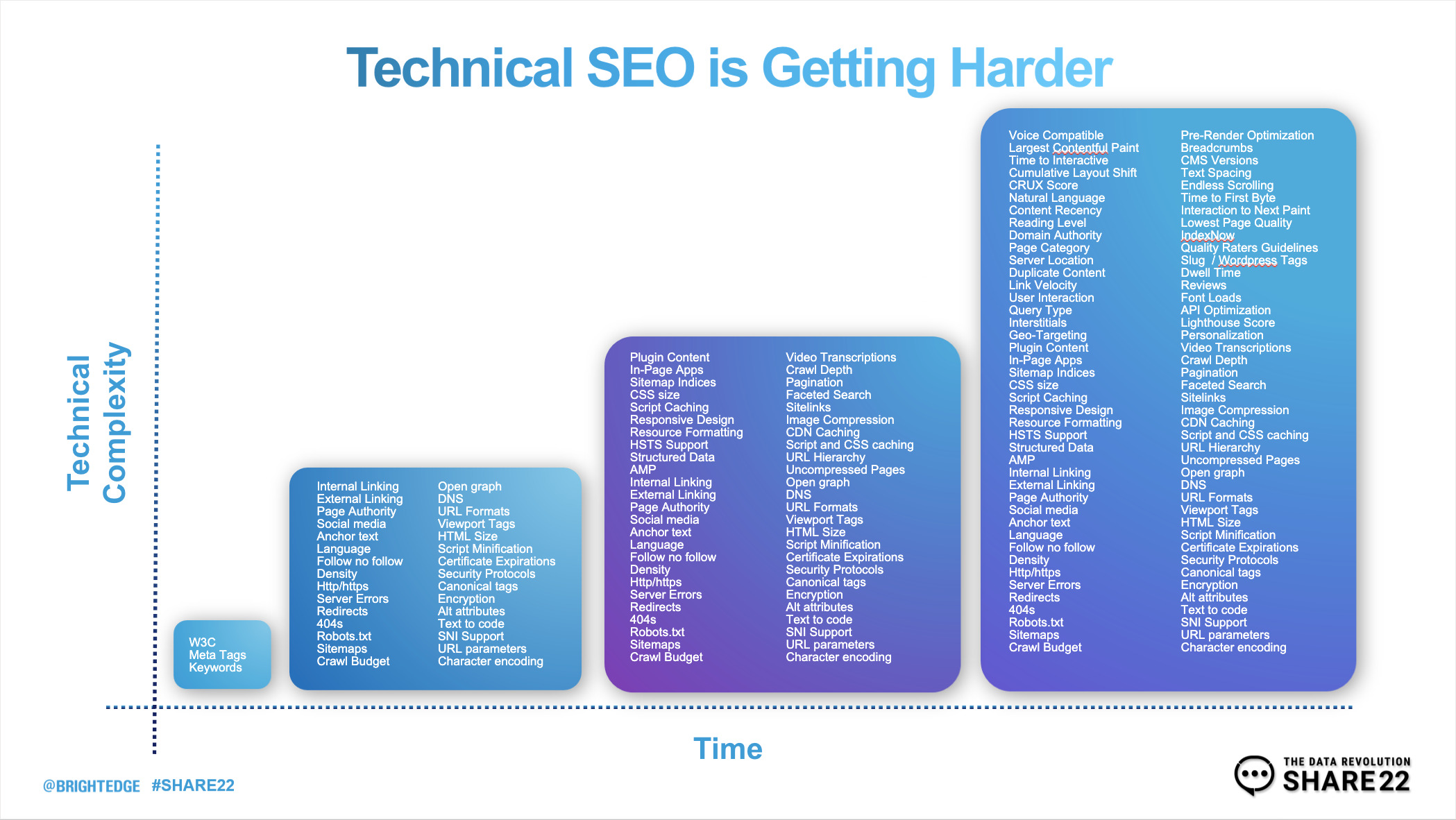In the evolving world of search, we need to always be thinking about how our brands and our content can be discovered. Competition for search audiences is fiercer than ever, search algorithms are increasingly intelligent and intuitive, and search lives well beyond the browser now, no longer tightly confined to a search engine search bar and results page. The web’s wild, wild west days are far behind, and the gleaming city filled with skyscrapers, superhighways, and a civilized society governed by law and order that emerged from the wild is now maturing, taking search right along with it.
That evolution has put us squarely in the midst of an SEO data revolution with more ranking factors and data points to consider. It is forcing us to rethink the way we communicate with search engines and how we go about increasing our digital footprint. SEOs are having to become more like data scientists — sourcing, compiling and analyzing data from any number of disparate sources to ensure their audiences can find them at the right moments.
Fundamentally, digital discovery starts with crafting the message in the right way (content optimization) but also requires optimizing the delivery and description of the content (technical SEO). There is an essential symmetry between the two. If ACME Widget Makers manufactures the ideal product for its customers, but fails to secure distribution, it will fail. Conversely, if ACME secures targeted distribution, but produces a sub-par product, it will fail. It must master both. Search has always relied on both elements, but the complexity has increased exponentially.
When we talk about SEO, the content optimization half of the equation gets a lot of the attention, but in 2022 and for the foreseeable future, technical SEO presents an equal if not bigger opportunity (or barrier, depending on how brands approach it) for maximizing digital discovery. How we approach technical SEO matters more than ever, because:
- Technical SEO is getting harder,
- The entry points to search and search results are expanding, and
- Customer behavior is less transparent
Technical SEO Is Getting Harder
With current advancements in search indexing, thanks in large part to machine learning and artificial intelligence (AI), it seems paradoxical to suggest that technical SEO is getting harder, but as search engines have grown more sophisticated, so have websites. Search engines are increasingly adept at indexing content, but the way we build websites is, too. The W3C table of contents is 209 pages alone and we still must account for Google and user experience standards. we still have to account for Google standards and user experience standards.
The focus for discoverability used to be almost solely centered on getting URLs indexed. Today we want search engines to not only index a URL, but to understand the context of the page, the format of the content to best match it to the right type of search results, and dozens of other signals embedded in our content and on our sites. Technical SEO is our best shot at controlling whether and how our content ranks in search. Consider the simple chart below, which puts in stark relief how progressively complex technical SEO has become.
The increasing complexity of technical SEO means operators of enterprise-grade websites need to mirror what search engines are doing by employing automation, AI and machine learning if they are going to be able to conform at scale with the myriad standards that determine whether a page gets indexed and ranked. Advanced tools like BrightEdge’s Anomaly Detection can help users cut through a site’s technical aspects to bring the things that matter into focus.
The Entry Points To Search and Search Results Are Expanding
Search is ubiquitous. Searches originate from traditional search engines, but they also come from sources like personal smart devices, home assistants, dedicated apps such as navigation apps, and are originated with natural language voice requests nearly as often as typed, keyword-based queries. Even the concept of a search engine has changed and become more specialized. A consumer looking to purchase a product is more likely to start at Amazon.com than they are to start at Google. Someone tracking the big stories of the day may turn to Twitter, while someone looking for instruction may rely on YouTube.
The Google search engine results page itself is specialized, offering 26 places to click in mobile search alone. It’s not uncommon for a search to generate local listings, image and video results, quick answers and people also ask results, news stories, product/shopping results and more.
It is not sufficient to publish a keyword-optimized piece of content and hope the search engines figure out how to use it. Technical SEO gives us the tools – schema markup, featured snippets, internal links, site structure elements, and much more – to tell the search engines how to use our content, giving it a better chance to be discoverable and to rank well.
Customer Behavior Is Less Transparent
Digital marketing ushered in an unprecedented era of personalization. Tracking technologies gave us the ability to connect a user’s actions to past, present and future behaviors. It made it possible to anticipate, encourage and respond with the content, products and services they wanted at a one-to-one level. Much of the digital marketing landscape – advertising, email marketing, social media marketing, etc. – relies extensively on these technologies to be effective.
SEO has benefited as well from the ability to connect a search result click to immediate and future behaviors. Knowing that a piece or type of content attracted the right type of customer behavior gives us the ammunition to refine other content to extend our reach for similar results. But now, two realities are disrupting the tracking-dependent worlds of digital marketers everywhere: zero-click results and privacy changes.
Zero-click results – search results like quick answers, local listings and people also ask – give searchers the information they are seeking directly on the search engine results page (SERP). As a result, SEOs and digital marketers can no longer look to click data to evaluate the performance of such content, because there is none. Instead, the focus has had to shift to maximizing their presence in zero-click results by ensuring their Google “My Business” listings are up to date, their reviews are plentiful, and their site’s information with structured data in the feed is up to date and correct. They’ve had to be mindful of schema, too, which helps a search engine understand context on a webpage so it can see, for example, which part of the page is the price of a product, or which is a review, or which are entities like the author of the page. All of this relies on technical SEO, and now without direct visibility into the outcomes, structuring technical SEO properly is more critical.
Another major change impacting digital marketers is significant new privacy protections. Apple started the ball rolling by opting users out of app tracking by default and, instead, prompting them to opt-in. Less than 5% of iPhone users have agreed to app tracking after being given the option. This is significant for any platform – like most social media platforms, for example – that rely on Apple-originated traffic. Google will be taking it a step further by phasing out third-party cookies and replacing them with: nothing. Google has said it will not build alternative identifiers. Customers have demanded data privacy and the marketing is responding. Soon, however, data privacy will no longer be just good business. Gartner predicts that by 2023, 63% of the world’s population will enjoy government-regulated personal privacy protections that by 2023, 63% of the world’s population will enjoy government-regulated personal privacy protections.
All of this means that targeted digital marketing, which relies so heavily on tracking to understand and predict consumer behavior, is taking a big step backward in the service of consumer privacy. Search – both organic and paid – can help marketers fill in the blanks.
Search is a gigantic marketing channel, but it’s also a very important listening channel. Keywords, the way search engines sense and respond to intents and the arbitration between what people want in a given moment and how it’s best delivered is something marketers can leverage. Search behavior is customer intent. The future of marketing will require turning all that intent data into a vehicle to deliver personalized experiences. Most importantly, we can do it without raising any privacy concerns whatsoever since we interpret a combination of anonymized and first party data to build our market analysis, leverage those insights to create winning content and optimize technical SEO to describe and present it in the ways consumers want to find and interact with it.
Key Takeaways
Several factors are elevating the importance of good technical SEO execution:
- Search is getting smarter, but websites have become exponentially more complex, too
- Search comes from many sources and search results take many forms
- Extensive changes to the richness of search results and sweeping new data privacy changes are obscuring the brand-to-customer interaction
In the face of these challenges, technical SEO is a key component to ensure we can be present in the right ways at the right times.

